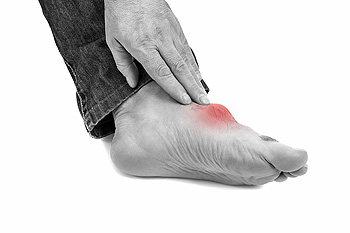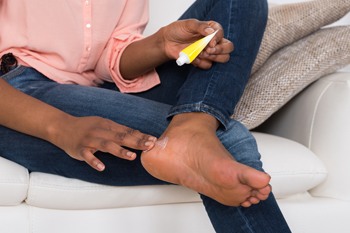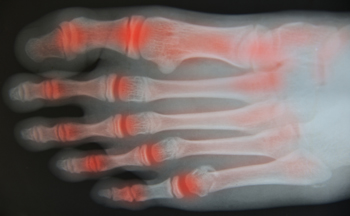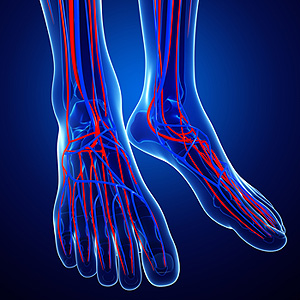May 2021
Nonsurgical Treatments for Foot and Ankle Arthritis
Osteoarthritis, the type of arthritis we associate with aging, can occur due to wear and tear of the cartilage that lines the joints. As the cartilage breaks down over time, the joints become stiff, painful, and swollen, making it difficult to walk, stand, and go about doing your daily activities. While osteoarthritis can affect any joint in the body, it often affects the joints of the feet and ankles. A podiatrist can help you manage and mitigate some of the symptoms of foot and ankle arthritis. There are many nonsurgical treatments for osteoarthritis, including taking oral medications or getting corticosteroid injections to reduce inflammation, wearing orthotics, bracing or immobilizing affected joints, and physical therapy. If you have arthritis in your feet and ankles, please see a podiatrist.
Arthritis can be a difficult condition to live with. If you are seeking treatment, contact Dr. Lee R. Stein from Lake Shore Foot & Ankle, PC. Our doctor can provide the care you need to keep you pain-free and on your feet.
Arthritic Foot Care
Arthritis is a joint disorder that involves the inflammation of different joints in your body, such as those in your feet. Arthritis is often caused by a degenerative joint disease and causes mild to severe pain in all affected areas. In addition to this, swelling and stiffness in the affected joints can also be a common symptom of arthritis.
In many cases, wearing ill-fitting shoes can worsen the effects and pain of arthritis. Wearing shoes that have a lower heel and extra room can help your feet feel more comfortable. In cases of rheumatoid arthritis, the arch in your foot may become problematic. Buying shoes with proper arch support that contour to your feet can help immensely.
Alleviating Arthritic Pain
- Exercises that stretch the foot can prevent further pain and injury and increase mobility
- Most of the pain can be alleviated with anti-inflammatory drugs, heat, and topical medications
- Massages can help temporarily alleviate pain.
It is best to see your doctor for the treatment that is right for your needs and symptoms. Conditions vary, and a podiatrist can help you determine the right method of care for your feet.
If you have any questions, please feel free to contact one of our offices located in Chicago, Highland Park, and Uptown, IL . We offer the newest diagnostic tools and technology to treat your foot and ankle needs.
Types of Peripheral Artery Disease
Peripheral artery disease (PAD) is a condition characterized by reduced blood flow to the lower limbs. This can cause symptoms such as leg cramps, pain, fatigue, numbness, skin discoloration, and foot wounds. There are two types of PAD. Occlusive PAD occurs when the blood vessels are blocked. This can be caused by the arteries thickening and hardening over time (atherosclerosis), an excess buildup of lymph fluid (lymphedema), blood clots forming in the veins of the leg muscles (deep vein thrombosis), or narrowed carotid arteries (carotid artery stenosis). Functional PAD occurs when the blood vessels are not blocked, but rather malfunctioning due to spasms. This can be seen in cases of varicose veins, Raynaud’s disease, and chronic venous insufficiency. Functional PAD is typically made worse or triggered by environmental or lifestyle factors, such as exposure to cold, excessive stress, and smoking. If you are experiencing any symptoms of PAD, it is suggested that you see a podiatrist.
Poor circulation is a serious condition and needs immediate medical attention. If you have any concerns with poor circulation in your feet contact Dr. Lee R. Stein of Lake Shore Foot & Ankle, PC. Our doctor will treat your foot and ankle needs.
Poor Circulation in the Feet
Poor blood circulation in the feet and legs is can be caused by peripheral artery disease (PAD), which is the result of a buildup of plaque in the arteries.
Plaque buildup or atherosclerosis results from excess calcium and cholesterol in the bloodstream. This can restrict the amount of blood which can flow through the arteries. Poor blood circulation in the feet and legs are sometimes caused by inflammation in the blood vessels, known as vasculitis.
Causes
Lack of oxygen and oxygen from poor blood circulation restricts muscle growth and development. It can also cause:
- Muscle pain, stiffness, or weakness
- Numbness or cramping in the legs
- Skin discoloration
- Slower nail & hair growth
- Erectile dysfunction
Those who have diabetes or smoke are at greatest risk for poor circulation, as are those who are over 50. If you have poor circulation in the feet and legs it may be caused by PAD and is important to make changes to your lifestyle in order to reduce risk of getting a heart attack or stroke. Exercise and maintaining a healthy lifestyle will dramatically improve conditions.
As always, see a podiatrist as he or she will assist in finding a regimen that suits you. A podiatrist can also prescribe you any needed medication.
If you have any questions please feel free to contact one of our offices located in Chicago, Highland Park, and Uptown, IL . We offer the newest diagnostic and treatment technologies for all your foot and ankle needs.
Gout Pain Can Be Managed
Causes and Possible Remedies for Gout
 The most common symptom of a foot condition that is referred to as gout, is intense pain in the joints of the big toe. It is considered to be a form of arthritis, and can occur from elevated uric acid levels in the bloodstream. It can develop for a variety of reasons, including genetic factors, taking specific medication, or from eating foods that have high levels of purines. These can consist of red meat, shellfish, and drinks that are made with large amounts of sugar. It is beneficial to limit the types of foods that can cause gout, and specific medication may be prescribed that can bring mild relief. If you have been afflicted with gout, it is strongly suggested that you are under the care of a podiatrist who can offer you correct treatment options.
The most common symptom of a foot condition that is referred to as gout, is intense pain in the joints of the big toe. It is considered to be a form of arthritis, and can occur from elevated uric acid levels in the bloodstream. It can develop for a variety of reasons, including genetic factors, taking specific medication, or from eating foods that have high levels of purines. These can consist of red meat, shellfish, and drinks that are made with large amounts of sugar. It is beneficial to limit the types of foods that can cause gout, and specific medication may be prescribed that can bring mild relief. If you have been afflicted with gout, it is strongly suggested that you are under the care of a podiatrist who can offer you correct treatment options.
Gout is a foot condition that requires certain treatment and care. If you are seeking treatment, contact Dr. Lee R. Stein from Lake Shore Foot & Ankle, PC. Our doctor will treat your foot and ankle needs.
What Is Gout?
Gout is a type of arthritis caused by a buildup of uric acid in the bloodstream. It often develops in the foot, especially the big toe area, although it can manifest in other parts of the body as well. Gout can make walking and standing very painful and is especially common in diabetics and the obese.
People typically get gout because of a poor diet. Genetic predisposition is also a factor. The children of parents who have had gout frequently have a chance of developing it themselves.
Gout can easily be identified by redness and inflammation of the big toe and the surrounding areas of the foot. Other symptoms include extreme fatigue, joint pain, and running high fevers. Sometimes corticosteroid drugs can be prescribed to treat gout, but the best way to combat this disease is to get more exercise and eat a better diet.
If you have any questions please feel free to contact one of our offices located in Chicago, Highland Park, and Uptown, IL . We offer the newest diagnostic and treatment technologies for all your foot and ankle needs.
Traditional Treatment for Cracked Heels
 If you find yourself with dry, cracked heels, home treatment is often enough to manage this problem and find relief. Moisturizing the feet regularly is important for maintaining smooth, hydrated skin. Following a bath or shower, coat your feet and heels with a moisturizing cream or lotion. Then, put on a pair of clean, dry socks to lock in the added moisture. You can also exfoliate your feet in the shower using a pumice stone to help remove dead, dry skin. If home remedies do not relieve your cracked heels, or if the cracks are deep, painful, or show signs of infection, please seek the care of a podiatrist.
If you find yourself with dry, cracked heels, home treatment is often enough to manage this problem and find relief. Moisturizing the feet regularly is important for maintaining smooth, hydrated skin. Following a bath or shower, coat your feet and heels with a moisturizing cream or lotion. Then, put on a pair of clean, dry socks to lock in the added moisture. You can also exfoliate your feet in the shower using a pumice stone to help remove dead, dry skin. If home remedies do not relieve your cracked heels, or if the cracks are deep, painful, or show signs of infection, please seek the care of a podiatrist.
If the skin on your feet starts to crack, you may want to see a podiatrist to find treatment. If you have any concerns, contact Dr. Lee R. Stein from Lake Shore Foot & Ankle, PC. Our doctor can provide the care you need to keep you pain-free and on your feet.
Cracked Heels
It is important to moisturize your cracked heels in order to prevent pain, bleeding, and infection. The reason cracked heels form is because the skin on the foot is too dry to support the immense pressure placed on them. When the foot expands, the dry skin on the foot begins to split.
Ways to Help Heal Them
- Invest in a good foot cream
- Try Using Petroleum Jelly
- Ease up on Soaps
- Drink Plenty of Water
Ways to Prevent Cracked Heels
- Moisturize After Showering
- Skip a Shower
- Keep Shower Water Lukewarm
- Don’t Scrub Your Feet
If you are unsure how to proceed in treating cracked heels, seek guidance from a podiatrist. Your doctor will help you with any questions or information you may need.
If you have any questions, please feel free to contact one of our offices located in Chicago, Highland Park, and Uptown, IL . We offer the newest diagnostic and treatment technologies for all your foot care needs.
Blog Archives
- April 2025
- March 2025
- February 2025
- January 2025
- December 2024
- November 2024
- October 2024
- September 2024
- August 2024
- July 2024
- June 2024
- May 2024
- April 2024
- March 2024
- February 2024
- January 2024
- December 2023
- November 2023
- October 2023
- September 2023
- August 2023
- July 2023
- June 2023
- May 2023
- April 2023
- March 2023
- February 2023
- January 2023
- December 2022
- November 2022
- October 2022
- September 2022
- August 2022
- July 2022
- June 2022
- May 2022
- April 2022
- March 2022
- February 2022
- January 2022
- December 2021
- November 2021
- October 2021
- September 2021
- August 2021
- July 2021
- June 2021
- May 2021
- April 2021
- March 2021
- February 2021
- January 2021
- December 2020
- November 2020
- October 2020
- September 2020
- August 2020
- July 2020
- June 2020
- May 2020
- April 2020
- March 2020
- February 2020
- January 2020
- December 2019
- November 2019
- October 2019
- September 2019
- August 2019
- July 2019
- June 2019
- May 2019
- April 2019
- March 2019
- February 2019
- January 2019
- December 2018
- November 2018
- October 2018
- September 2018
- August 2018
- July 2018










